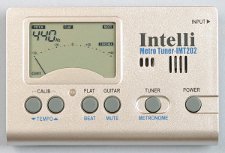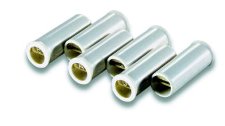WITH A TUNER
Electronic tuner

This tuning is probably the only way we can tune the guitar, whether our hearing is anyhow developed. Another advantage is the possibility of tuning even in the presence of greater noise. All this, assuming we have a charged battery and we can handle the tuner. So we are very dependent on the battery, and the other extra thing we have to carry with us. If we forget the tuner at home or just stop working, we probably will not be guitarist.
These tuners have built-in other features such as metronome, tuning to different frequencies, or tuning of other instruments (bass).
What to watch out for when tuning:- Consider whether the battery no longer needs to be replaced.
- Make sure you have tuning for the guitar turned on.
- Verify the frequency you want to tune. Standard tuning is at 440Hz. If you decide for another frequency, be aware that your instrument may not resonate at this frequency. The vast majority of guitars are built at just 440Hz. In addition, if you play together with other instruments, it can be assumed that they will be tuned to 440Hz, especially those that have fixed tuning (piano, wind instruments, ...). The tuning frequency of most tuners is shown on the display directly during tuning (see picture below).
- Place the tuner as close as possible to the resonant hole. (Only applies if you do not have a type of tuner that attaches to the head of the guitar.)
- Make sure that the string you are stretching is really the one you want to tune (sometimes you feel that you are stretching, for example, the D string, while rotating G).
- Note that if you debug the H string, the tuner will show the letter B if the notation system is set to English/US tuning. Check that your notation style is set properly.
I'm not too much a fan of electronic tuners, because they do little to heal when using them. When tuning the string according to the tone we listen to, we train music memory and then we are closer to tuning ourselves without any aid. Which is the ideal situation.
Blow tuning

Works on the principle of a small "harmonica", each whistle representing a single string tone. The disadvantage may be the need for hearing and, in case of ill-treatment, the possibility of tongue inflation.
Using metal tuner

It has a great advantage due to its accuracy, simplicity, durability and size. We hold the ladder behind our feet, shake the throw of something, then put the end of the foot on the front of the guitar and we should sound the tone A at the frequency of 440Hz, which is on the guitar of e1 strung on the 5th field. Then we follow the tuning rules according to one string.





